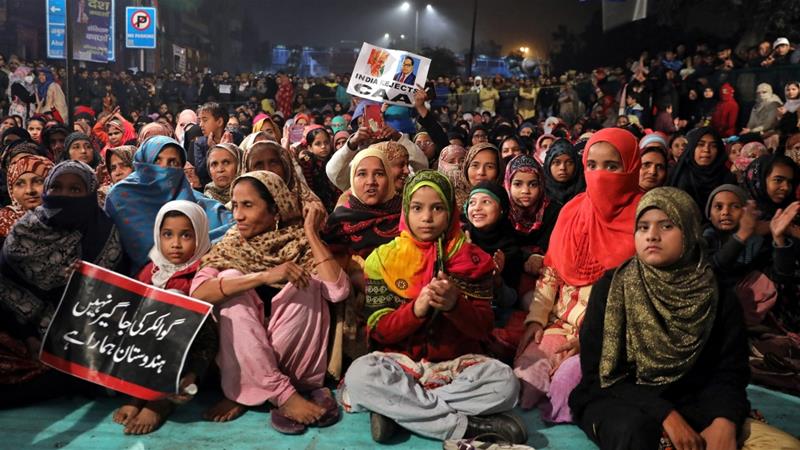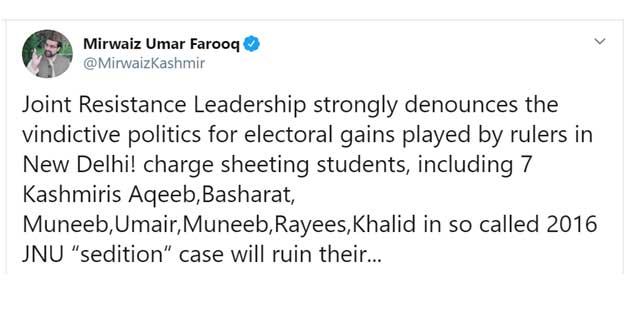
At the helm of massive protests against CAA-NRC, indiscriminate slapping of charges against protestors criminalizes the democratic foundation of protest. This rampant haze of identifying the ‘criminal’ protestor brings about questions- and demands a deeper reflection over the vilification campaign run by the sensationalist media.
The liberal model of democracy in India has revealed its fissures and cracks time and again- perhaps more vicariously than ever- in its functional appartus of standing as a paragon of protecting fundamental rights of the citizens. In the wake of massive protests across the country against CAA-NRC, what we see is an equivalent retaliation by the state to suppress or perhaps disintegrate the focalized voices of resistance with rampant slapping of charges against the protestors. The ground for criminalizing protests has been opened up by charging sedition, NSA, UAPA at the national level to Goonda Act at regional level followed by inordinate detaining of activists and protestors at different parts of the country.
The surveilling eye of the state is in a rampant haze of identifying the ‘criminal’ protestor amongst the teeming crowd. Its biopolitical agenda is further aided by media that selectively showcases individuals in a potentially ‘criminal’ light through its unverified media trials.The protestor who protests, and expresses dissent is identified as “criminal” paradoxically in a democratic structure that enables dissent. What is interesting to note here is that, more than the print media, it is the electronic media due to their wide accessibility amongst the popular audience churns out sensationalist news. Yet in the recent years, there have been significant proliferation of news websites like opindia that supplies sensationalist news.
Preceding the court of judicial enquiry, the court of media incriminates the individual by churning out narratives through doctored videos and other unverified means to build up a case. In the spate of recent events, Sharjeel Imam, an emerging voice in the Anti-CAA movement, whose media trial in Republic Tv had landed him into incarceration with various other charges slapped on him by five States of India. Apart from Sharjeel Imam, Afreen Fatima, a Student leader from JNU also faced similar vilification attempts. The peremptory judgements of media to declare an individual guilty or not guilty along the line of charges framed by the media itself is an exercise gaining popular sensalization. Even before the case reached the court, the reputation of the individual is tarnished before the public. Media creates the ground for incriminating individuals in the eyes of the public and the state. Supreme Court writes the role of media in a judgement of Anand vs Delhi High Court (2009):
“the impact of television and newspaper coverage on a person ‘s reputation by creating a widespread perception of guilt regardless of any verdict in a court of law. During high publicity cases, the media are often accused of provoking an atmosphere of public hysteria akin to a lynch mob which not only makes a fair trial impossible but means that regardless of the result of the trial, in public perception the accused is already held guilty and would not be able to live the rest of their life without intense public scrutiny.”
Media trial precedes legal trial-as one could say in the current situation of prosecution of individuals.
Media and Public Perception
The trajectory of media narrative aligns with the dominant narrative and stereotypes of the cityscapes of India. In the recent CAA-NRC protests, Shaheen Bagh was taken as the epicentre of vilification campaign by the media. In one of the attempts at vilification, the sensationalist media accussed the women of charging money for a sit-in protest everyday. The chakka jam (road blockade) model of protest in Shaheen Bagh initiated a wide proliferation of such model to other parts of India from U.P to Bihar and West Bengal. The sensationalist media in the line of villifying such protest had been churning narratives to bash CAA-NRC protests across India.
In 2016, the sedition charges that were slapped on Umar, Anirban and Kanhiaya and seven Kashmiri students by the name of Aquib, Basharat, Muneeb, Umair, Mujib, Rayees and Khalid by the State was performed first through a media vilification of these individuals. However, for the latter, in the case of Kashmiri students- their presence and their names were invisibilized. In the year and the coming years, the sensationalist media created a discourse of screening individuals with nationalist and anti-national predisposition towards the state. Media’s run-through campaign of sedition charges also somehow overplayed a larger identity politics. A formidable pattern emerges from such repetitive instances: Implicit in these trials are the specific “other” that media creates to vilify. In the case of 2016 sedition case, Umar and Anirban had to face the brunt of the media for their radical left politics and in the recent case of Sharjeel Imam, who is facing the brunt of the media for being an assertive “vocal” muslim. Hitherto, the names of Kashmiri students were forgotten in the sensationalist jibe of the Media, while the latter was interested in bashing and creating narratives about the so-called “anti-nationalist” disposition of Umar and Kanhaiya. Being silent, like Indian Media has always been on Kashmir- is also a kind of “othering”. The screening of prominent activists whose involvement in the Anti-CAA protests are the “others” in the books of the state.

Media with other forms of social media platforms, by explicitly visbilizing the faces of the protestors, have put their lives under precarious condition. In a reporting of The Wire, the U.P government pasted the photos of 28 people involved in CAA-NRC protest which included the pictures of Congress activist Sadaf Jafar, retired police officer S.R Darapuri and activist poet Deepak Kabir on the hoardings of home addresses and strategic traffic points.
Living in these precarious times, where lives are constantly endangered by the instruments of state- big hoardings, media trials act as gigantic spectacles of vilification in the public domain as well as mediums of visibilization of individuals putting not just reputation but their lives in a precarious condition under the precarious regime of the State.
Nilanjana Bhattacharya is currently pursuing her Masters in English from Jawaharlal Nehru University. She can be contacted at [email protected]
SIGN UP FOR COUNTERCURRENTS DAILY NEWS LETTER










































